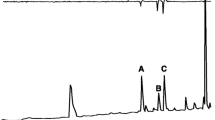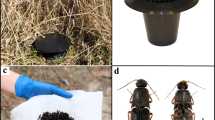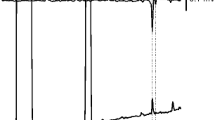Abstract
Giant silk moths (Lepidoptera: Saturniidae) typically are not well represented as larvae or adults in community level inventories of Lepidoptera, and as a result, little is known about their population dynamics. Furthermore, in recent years, many species of silk moths appear to have experienced population declines. Volatile sex pheromones are powerful sampling tools that can be used in operational conservation and monitoring programs for insects. Here, we describe the identification of the sex attractant pheromone of a giant silk moth, the luna moth Actias luna. Coupled gas chromatography-electroantennographic detection and gas chromatography-mass spectrometric analyses of extracts from pheromone glands of female luna moths supported the identification of (6E,11Z)-6,11-octadecadienal (E6,Z11–18:Ald), (6E)-6-octadecenal (E6–18:Ald), and (11Z)-11-octadecenal (Z11–18:Ald) as the compounds in extracts that elicited responses from antennae of male moths. These identifications were confirmed by synthesis, followed by testing of blends of the synthetic compounds in field trials in Ontario, Canada, and Kentucky, USA. Male moths were attracted to synthetic E6,Z11–18:Ald as a single component. Attraction appeared to be enhanced by addition of E6–18:Ald but not Z11–18:Ald, suggesting that the luna moth pheromone consists of a blend of E6,Z11–18:Ald and E6–18:Ald.



Similar content being viewed by others
References
Analytical Software (2013) Statistix 10 User’s Manual. Tallahassee, FL
Baker WL (1972) Eastern forest insects. USDA Forest Service, Miscellaneous publication no. 1175, Washington DC
Benjamini Y, Hochberg Y (1995) Controlling the false discovery rate: A practical and powerful approach to multiple testing. J Royal Stat Soc B 57:289–300
Boettner GH, Elkinton JS, Boettner CJ (2000) Effects of a biological control introduction on three nontarget native species of saturniid moths. Conserv Biol 14:1798–1806
Bouseman JK, Sternburg JG (2002) A field guide to silkmoths of Illinois. Illinois Natural History Survey Manual 10. Illinois Dept. of Natural Resources,, Springfield IL, p. 97 pp
Brown CA, Ahuja VK (1973) Catalytic hydrogenation. VI. Reaction of sodium borohydride with nickel salts in ethanol solution. P-2 nickel, a highly convenient, new, selective hydrogenation catalyst with great sensitivity to substrate structure. J Org Chem 38:2226–2230
Buck M, Chong JM (2001) Alkylation of 1-alkynes in THF. Tetrahedron Lett 42:5825–5827
Butler L, Stazanc J (2000a) Occurrence of Lepidoptera on selected host trees in two central Appalachian national forests. Ann Entomol Soc Am 93:500–511
Butler L, Stazanc J (2000b) Macrolepidopteran larvae sampled by tree bands in temperate Mesic and xeric forests in eastern United States. Proc Entomol Soc Wash 102:188–197
Corey EJ, Schmidt G (1979) Useful procedures for the oxidation of alcohols involving pyridinium dichromate in aprotic media. Tetrahedron Lett 20:399–402
El-Sayed, AM (2016). The pherobase: Database of pheromones and semiochemicals. http://www.pherobase.com. Accessed June 1, 2016.
Ferguson, DC (1971) The moths of America north of Mexico: Fascicle 20.2 A Bombycoidea Saturniidae (Part). E.W. Classey Limited and R.B.D. Publications, London
Gago R, Allison JD, McElfresh JS, Haynes KF, McKenney J, Guerrero A, Millar JG (2013) A tetraene aldehyde as the major sex pheromone component of the promethea moth (Callosamia promethea (Drury. J Chem Ecol 39:1263–1272
Garcia LV (2004) Escaping the Bonferonni iron claw in ecological studies. Oikos 105:657–663
Holden C (1992) Thousands of insects “enroll” at Yale. Science 256:313
Johnson KS, Scriber JM, Nitao JK, Smitley DR (1995) Toxicity of Bacillus thuringiensis var kurstaki to three nontarget Lepidoptera in field studies. Environ Entomol 24:288–297
Kellog SK, Fink LS, Brower LP (2003) Parasitism of native Luna moths, Actias luna (L.) (Lepidoptera: Saturniidae) by the introduced Compsilura concinnata (Meigen) (Diptera: Tachinidae) in Central Virginia, and their hyperparasitism by trigonalid wasps (hymenoptera: Trigonalidae. Environ Entomol 32:1019–1027
Larsson MC, Svensson GP (2009) Pheromone monitoring of rare and threatened insects: Exploiting a pheromone-kairomone system to estimate prey and predator abundance. Conserv Biol 23:1516–1525
Le Corff J, Marquis RJ, Whitfield JB (2000) Temporal and spatial variation in a parasitoid community associated with the herbivores that feed on Missouri Quercus. Environ Entomol 29:181–194
Lindroth RL (1989) Chemical ecology of the Luna moth: effects of host plant on detoxification enzyme activity. J Chem Ecol 15:2019–2029
Löfstedt C, Wahlberg N, Millar JG (2016) Evolutionary patterns of pheromone diversity in Lepidoptera, Chapter 4. In: Allison JD, Cardé RT (eds) Pheromone communication in moths. University of California Press, Berkeley
Marquis RJ, Passoa S (1989) Seasonal diversity and abundance of the herbivore fauna of striped maple Acer pensylvanicum L. (Aceraceae) in western Virginia. Am Midland Nat 122:313–320
McCune B, Grace JB, Urban DL (2002) Analysis of ecological communities. MjM Software Design, Gleneden Beach
Millar JG, McElfresh JS, Romero C, Vila M, Mari-Mena N, Lopez-Vaamonde C (2010) Identification of the sex pheromone of a protected species, the Spanish moon moth Graellsia isabellae. J Chem Ecol 36:923–932
Peigler RS (2001) We now know what happened to our biggest moths. News Lepidop Soc 43:30
Schweitzer DF (1988) Status of Saturniidae in the northeastern USA: A quick review. News Lepidop Soc 1:4–5
Sonnet PE, Heath RR (1980) Stereospecific synthesis of (Z,Z)-11,13-hexadecadienal, a female sex pheromone of the navel orangeworm, Amyelois transitella (Lepidoptera: Pyralidae. J Chem Ecol 6:221–228
Thomas AW (1996) Light-trap catches of moths within and above the canopy of a northeastern forest. J Lepidop Soc 50:21–45
Thomas AW, Thomas GM (1994) Sampling strategies for estimating moth species diversity using a light trap in a northeastern softwood forest. J Lepidop Soc 48:85–105
Tietz, HM (1972) An index to the described life histories, early stages and hosts of the macrolepidoptera of the continental United States and Canada. A. C. Allyn, Sarasota FL, USA
Tuskes PM, Tuttle JP, Collins MM (1996) The wild silk moths of North America. Cornell University, Ithaca NY, USA
Wagner DL, Peacock JW, Carter JL, Talley SE (1996) Field assessment of Bacillus thuringiensis on non-target Lepidoptera. Environ Entomol 25:1444–1454
Wang HL, Liénard MA, Zhao CH, Wang CZ, Löfstedt C (2010) Neofunctionalization in an ancestral insect desaturase lineage led to rare ∆6 pheromone signals in the Chinese tussah silkworm. Insect Biochem Molec. Biol 40:742–751
Wiskur SL, Korte A, GC F (2004) Cross-couplings of alkyl electrophiles under “ligandless” conditions: Negishi reactions of organozirconium reagents. J Am Chem Soc 126:82–83
Acknowledgments
Nick Boyonoski and Scott Bessin provided technical assistance, Dr. Martha Lutz reared the first generation of luna moths in Kentucky, and Dr. Eric Chapman helped find suitable field locations in Kentucky. Clint Patterson, Berea College Forester, provided us with access to the Berea College Forest. The experiments conducted in Kentucky were supported by the Kentucky Agricultural Experiment Station (National Institute of Food and Agriculture, U.S. Department of Agriculture, Hatch Project KY008066 1003549), the experiments in Ontario were supported by Natural Resources Canada, and JGM acknowledges support from Hatch Project CA-R*ENT-5181-H.
Author information
Authors and Affiliations
Corresponding author
Rights and permissions
About this article
Cite this article
Millar, J.G., Haynes, K.F., Dossey, A.T. et al. Sex Attractant Pheromone of the Luna Moth, Actias luna (Linnaeus). J Chem Ecol 42, 869–876 (2016). https://doi.org/10.1007/s10886-016-0751-6
Received:
Revised:
Accepted:
Published:
Issue Date:
DOI: https://doi.org/10.1007/s10886-016-0751-6




